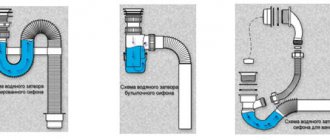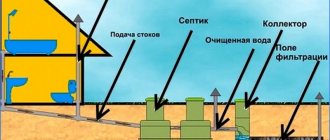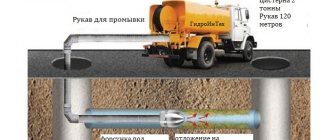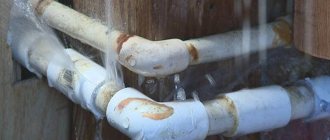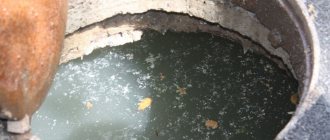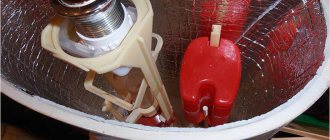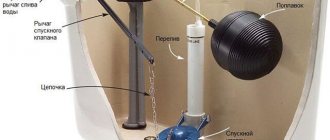We have an air lock in the sewer, how can we eliminate it and prevent it from appearing again? Similar questions often appear on thematic forums or other public pages dedicated to the operation of drainage systems.
The problem is quite rare, but this only makes it more complicated - few people understand the reasons for its occurrence. Eliminating such a malfunction is not easy - you must first find the place where it appeared, find out the cause, and only then correct the configuration of the drainage line. The problem will not disappear on its own; it must be solved immediately. Let's figure out together how air pockets appear and what to do about them.
Types of sewer clogs
If the sewer system in a house is operated in violation of all the rules for its use, then over time, blockages and plugs inevitably appear in the collector, which impede or completely stop the flow of wastewater. As a result, either someone from an apartment building or the owners of a private building will suffer from at least an unpleasant odor in the living space. The maximum possible flooding of the kitchen or bathroom with fecal water. This is not very pleasant, so to avoid such situations you need to use the collector correctly, namely:
- It is strictly forbidden to flush used personal hygiene items, such as pads, diapers, tampons, etc., down the toilet. Only flushing toilet paper is allowed.
- It is prohibited to flush bulk construction mixtures such as cement, sand, chalk, clay, etc. down the drain.
- Accidental flushing of rags and other similar items down the drain should be avoided.
- It is advisable to install grease traps in the kitchen, which will prevent the deposition of heavy greasy deposits on the walls of the collector. This, in turn, can create fecal growths-stalactites in the system and impede the flow of gray water.
It is always worth remembering that a traffic jam can form either in a specific place in the sewer system in an apartment or in a private house, or at any point in the central riser. If the last option is checked, then the drains will have nowhere to go but to return back from the blockage under the influence of hydraulic force. As a result, fecal or gray water will try to escape through the unoccupied openings of the bathtub, sink, and other plumbing fixtures.
Damage to enamel
Ceramic toilets, the most common, are coated with a smooth glaze or enamel
Over time, the coating wears out, and when struck by carelessness, scratches, chips and cracks remain on it. As a result, the smooth surface turns into a rough one and begins to resist the flushing of sewage.
Damage to the enamel is a sure sign that it is time to purchase a new toilet, but if there is no opportunity to do this yet, they resort to temporary restoration:
- After rinsing and drying the toilet, rough areas are treated with fine-grained sandpaper;
- thoroughly wash the toilet so that no dust remains, then dry and degrease;
- waterproof sealant or ceramic putty is applied to problem areas;
- after waiting for the mixture to dry completely, paint the treated areas with powder paint using a paint gun;
- wait for the paint to dry completely (about 3 days are required) and resume operation of the device.
The improvised glaze does not last long, so it is recommended to plan to purchase a new toilet in the near future.
What kind of blockages can there be and how to determine their cause
All sewer blockages are divided into several types:
- adhesion of fat to the internal surfaces of the pipe and adhesion of other waste. Such a blockage is usually called operational;
- the mechanical appearance differs from the previous one in that the cause of clogging is the entry of a foreign object into the system;
- as a result of the appearance of a fatty layer, a siphon blockage may occur;
- There is also a man-made problem, the cause of which is an error during installation of the system.
If the main access riser on the lower floor becomes clogged, then all the contents in the pipe rise up and come out in someone’s toilet, bathroom or kitchen. In such situations, you need to urgently call a specialist, since it is unlikely that you will be able to fix the problem yourself.
Finding an air lock in a sewer pipe
Ways to solve the problem
You can use regular soda to clean drains. To dilute the correct solution, you need to prepare several liters of boiling water in which a pack of soda will dissolve. The prepared liquid should be poured into the drain hole, and it is recommended to gradually add vinegar. In this way, a reaction can be achieved that will promote the rapid decomposition of fat
Most often, this method is used if there are no special means at hand, which include Mole, Tiret, etc. You can use chemicals yourself, but it is important to follow basic safety rules. Immediately before cleaning the sink, toilet or bathtub, you need to familiarize yourself with the operating instructions for a particular product.
It is better to use this cleaning method when the pipe is not yet completely clogged, this way you can achieve greater efficiency. When the drain is completely clogged, it is dangerous to use chemicals because they can back up into the bathtub or sink. A proven and reliable method of cleaning is to use a simple plunger. When actions using soda or chemicals do not bring much effect, then this method can be used. In such cases, it is important that the bowl of the plunger completely covers the drain hole.
How to fix the problem using a plunger?
Actions are performed in a certain sequence:
- a sample filter is removed from the hole;
- the top hole of the bathroom must be tightly closed to achieve greater efficiency during the work process;
- The plunger must be installed so that no air lock appears, while the handle is placed vertically;
- without lifting the device from the bottom of the bathtub, you need to move the device up and down;
- on the last movement, the plunger rises from the water to check the effectiveness of its drainage. If necessary, the procedure is repeated several more times.
Another proven device is a metal cable, which is often used by plumbers. At one end of such an object there are fluffy wires, on the other side of the cable there is a handle for convenient use. The first end is inserted into the pipe, and rotational movements must be made using the handle. Depending on the degree of pipe clogging and the location of the problem, cleaning can take a relatively long time. If the problem is solved quickly, then the length of the cable is sufficient to effectively penetrate the sewer.
Leaking toilet tank
Fixing the problem of a leaking tank is a completely doable task, but quite troublesome. First you need to look at the reasons for this problem:
Related article: Main types of upholstered furniture
Diagram of the drain tank.
- The bulb seat is clogged. It needs to be cleaned.
- Deformation, wear of the pear. Complete replacement of the pear. They are sold freely in plumbing stores.
- Destruction of steel (plastic) bolts. Because of this, water flows through the holes to the shelf. In this case, it is possible to either replace the damaged bolts or completely replace the complete set.
- Float deformation. In this case, the float allows water to pass through, loses its tightness, and its weight increases. As a result, it sinks, which affects the operation of the toilet. To solve the problem, you need to dismantle the float and install a new one. If it is impossible to make a replacement, it is necessary to seal the damaged float. Sealing is carried out using plastic, which fills the cracks in the molten state. After which the float is placed in a plastic bag and attached to the lever.
- Damage to the siphon membrane. In this case, the membrane should be replaced.
To do this you need:
- drain water;
- unscrew the nuts securing the tank to the flush pipe;
- slightly unscrew the siphon nut at the base of the cistern;
- dismantle the siphon;
- change the membrane;
- assemble the parts in the appropriate order.
Danger of air bubbles in the pipeline
Bubbles, especially large ones, can destroy even strong elements of the highway. The main troubles they cause to owners of private houses:
- They accumulate in the same areas, leading to breakdowns of pipe sections and adapters. They also pose a risk for turning and twisting pipe sections where air is trapped.
- They break the water flow, which is inconvenient for the user. The taps “spit out” water all the time and vibrate.
- Causes water hammer.
Water hammer leads to the formation of longitudinal cracks, which causes the pipes to gradually collapse. As time passes, the pipe breaks at the point of cracking and the system stops functioning.
Therefore, it is important to equip additional elements that allow you to quickly get rid of dangerous bubbles
Let's sum it up
As you can see, there are not many reasons why water may leak in the toilet. Therefore, in principle, even an untrained person can cope with the problem.
It is only important to carefully read the instructions and act consistently and carefully. Then everything will work out - the toilet will work without failures. Is your toilet tank leaking? Well, let it flow - it’s not the biggest problem
After all, the flowing water will still flow into the sewer. And many homeowners think so. Until you receive a bill for your water consumption
Is your toilet tank leaking? Well, let it flow - this is not the biggest problem. After all, the flowing water will still flow into the sewer. And many homeowners think so. Until they receive a bill for the water consumed.
After this, they come to a belated understanding of the danger of the situation when your own money flows from the tank into the sewer, almost before your eyes. Therefore, a leak in the toilet flush tank must be repaired immediately, immediately after discovering this defect in the operation of your plumbing equipment. And in this article we will tell you how this is done.
How to fix a leaking toilet cistern if you are not familiar with its design? Of course not. Therefore, before reviewing the repair technology, we will dive into the structure of the object being restored.
A typical tank consists of the following elements:
- Float valve (faucet)
- a fitting connected to the water supply system, on which a shut-off unit controlled by a float is attached. If there is no water in the tank, the float pulls the valve shut-off element down, opening the fitting. When the tank is filled, the float rises up, closing the fitting. - Overflow
- a hollow column connected to the toilet. This column protects the tank from overflowing. When the water level reaches the edge of the column, the liquid will overflow into the toilet rather than rush into the toilet room. - Drain valve
- a hatch mounted on a hinge that closes the drain hole leading to the toilet. If the hatch is closed, water from the float valve fills the tank. If the hatch is open, then all the liquid accumulated in the tank flows down the drain hole into the toilet.
drain lever
– drain valve control mechanism. This unit consists of a rack with a rocker arm, the edge of which is connected to the valve (hatch) with a polymer or metal chain. By pressing on the free edge of the rocker, you pull the chain up and open the valve hatch. By releasing the lever (yoke), you loosen the chain and lower the hatch into place.
Of all the components described above, only the first three elements can provoke a leak in the toilet - tap, overflow, valve. Therefore, repairing a toilet cistern leak involves restoring the functionality of these particular components.
.
As you can see: there is nothing complicated in the design of the drain system. But enough theory, it’s time to move on to repairs.
Where to start the renovation?
Of course, starting with finding the cause of the water leak. After all, only by understanding why the toilet tank is leaking will you be able to eliminate the defect and establish normal operation of the drainage structure.
And there may be several reasons for this, but most often plumbers deal with the following options:
The first option is a leak through the overflow
– Diagnosed very simply – water is constantly flowing in the toilet cistern. It’s as if we have a bottomless structure in front of us, and not a container of 10-12 liters (or even less). Therefore, if you hear the murmur, get ready to change or repair the parts of the float valve.
The second option is a defective sealing gasket.
– noticeable by a constant stream that forms a characteristic limescale “drip” on the inner surface of the toilet bowl. If you see it, get ready to dismantle the tank and change the gasket.
The third option is a weakened drain valve.
– diagnosed by an intermittent stream flowing from the drain nozzles into the toilet bowl as water enters the tank. Therefore, if, while filling the container, water flows from the tank into the toilet, without any options, get ready to change the valve shut-off element.
As you can see: there are not so many prerequisites for the formation of a leak. However, each of them requires its own approach to repair. Therefore, next we will consider three technologies for eliminating leaks, linked to three reasons for its formation.
How does education happen?
The correct start of the heating system is one in which it is filled through the return line using a make-up pump. When filling the system through the return line, the filling process is performed from the bottom up, the coolant gradually begins to fill all pipelines and heating devices, and excess air rises. As a result, it is very easy to drain it from the system using air collectors located at the highest points.
However, the process, sequence and incorrect start-up are not the only reasons why an air lock forms in the heating system. During operation of the heating system, air is sucked in through flange and threaded connections, as well as other existing leaks, which leads to the formation of a plug.
Installation rules
If it is impossible to fix the breakdown and the siphon needs to be changed, experts recommend knowing and using the rules for installing and dismantling the device.
Stages of dismantling:
- disassembling a deformed device;
- disconnecting the siphon and adjacent pipes from the sewer;
- removal of dirt and residues of rubber parts.
Before installing a new device, be sure to check that all components are included in the purchased kit.
The set contains:
- outlet pipe;
- plastic nuts;
- gaskets for inlet and drain;
- stainless steel clamping screw;
- conical rubber cuff;
- drain cover;
- curved pipe or special flask;
- rubber plug.
Only if all the above parts are available can you begin to install the product.
Installation steps:
- preliminary assembly of the structure;
- connection of the overflow to the bathtub;
- tight fixation of all elements and simultaneous use of sealing parts;
- installation of the main drain and pipe;
- siphon installation.
Mayevsky crane
Design of the Mayevsky crane
It is designed to eliminate air lock in the heating battery. Despite its small size, the Mayevsky faucet helps to effectively remove accumulated steam not only in radiators, but also in pipes.
Structurally, it is a needle valve enclosed in a metal housing. How to remove an air lock from a heating system using it? First you need to decide on the device model.
Manual taps
After installation in the upper radiator pipe, air is released after turning the union nut on the tap. Removing an air lock from the heating system using a Mayevsky manual tap is carried out according to the following scheme:
- Filling the system with coolant. The taps on the radiators are closed;
- When the maximum level is reached, the water supply stops;
- Having set the required gap of the needle limiter in the devices, the taps are opened;
- At the same time, the coolant supply is restored.
Water is added to the system until liquid begins to flow from all Mayevsky taps. Be sure to check that there is no air flow. This method is effective for removing air locks in heating radiators when starting the system for the first time, before the season, or when airiness appears during operation.
Manual models will effectively eliminate air lock in the radiator for both autonomous and central heating. The main thing is to choose the right mounting thread. In most cases it is 1/2", but there are models with a non-standard size of 3/4".
Automatic taps
Mayevsky automatic crane
Unlike the model described above, in their design, a seat with a certain surface area is installed on the end of the needle valve. In combination with a return spring, the degree of pressure of which determines the critical pressure value at which the valve opens. A detailed device is designed to automatically break through a heating plug when a critical temperature value and, as a result, pressure is exceeded.
However, before installation you should familiarize yourself with the specifics of this model:
- To prevent water from getting onto the floor, the structure must have a pipe to drain excess water into the sewer;
- If it sits for a long time, the valve seat may become covered with limescale, which will make it difficult to open. Therefore, it is recommended to open the tap manually once every 2-3 months. The steps of the procedure must be done before starting the heating for the first time;
- The set maximum opening pressure should not exceed the critical pressure of the entire system. In order to remove an air lock from the heating in automatic mode, the pressure value on the tap should be 5-10% less than the maximum.
What is better to install: an automatic or manual Mayevsky crane? If the operation of the system does not involve sudden pressure surges, manual models can be installed on the radiators. For autonomous heating, preference is given to automatic ones.
It is best to choose models made of brass. During the expulsion of an air lock from the heating, they can withstand not only a critical pressure value, but also a temperature. The steel body is subject to destruction and rusting.
The water supply is incomplete or missing
Diagram of a bowl toilet with a vertical outlet.
The toilet does not flush well even when there is little water in the cistern. As a result of the constant flow of water into the tank and the outflow of water from it into the toilet, the tank is not filled to its full extent.
A similar situation when the toilet does not flush occurs due to a malfunction of the float valve. Due to the fact that the valve is not adjusted, the water stops early. In this regard, the tank runs empty, the water simply does not have time to fill. The problem is solved by adjusting the float. Older toilet models have a brass lever that can be simply bent off. Newer models require the float to be adjusted using two plastic latches.
Flushing water will not be possible if water does not fill the tank. A similar situation when the toilet does not flush can arise for several reasons:
Float valve clogged. The valve contains a nozzle, which by its nature becomes clogged excessively quickly with small debris or limestone. To eliminate this situation, you should install the simplest filter in front of the tank. It would not hurt to install a filter directly in front of the valve at the water supply inlet. This problem can be solved step by step:
- turn off the water;
- remove the pin securing the float handle;
- remove the handle and float from the valve;
- remove any existing debris from the valve nozzle;
- open the water for a few seconds. Thus, the remaining dirt will come out along with the flow of water;
- assemble the parts into the final state.
If the blockage occurs due to a foreign object getting into the toilet and it is not possible to reach it, you must turn off the water supply and use tweezers to remove the debris.
Diagram of the drain tank.
The barrel is clogged with slag, the liner is blooming. This problem mainly affects steel pipes. In this case, you just need to clean the liner. To do this you need:
- turn off the water;
- unscrew the rubber liner of the tank;
- unscrew the valve that shuts off the water supply. In the case where a ball valve is installed, it is enough to just open it all the way;
- Point a special device into the pipe and rotate it so that the dirt comes out through it. If it was not possible to clear the blockage in this way, then with the device inside you need to turn on the water for a couple of seconds. But before doing this, be sure to place a container to drain the water. If the water comes out in a strong stream and stops, the device should continue to rotate. Then pull it out through the clogged area. After these steps, the water will flow at normal pressure.
It should be clarified that polymer and metal-plastic pipes are not susceptible to water blooming. Having paid once for reliable pipes, you won’t have to worry about fixing the problem.
Fixing the problem
You can solve the air lock problem yourself. The main thing is to identify the reason for its formation.
- First, it is worth inspecting the pipeline along its entire length for cracks or depressurization (provided that the sewerage system has a water seal). If any are found, it is worth replacing the collector section with a whole one. In this case, the air will freely flow into the drain pipe during a volley discharge of water into the system. That is, the water seal cover will close when the pressure in the pipeline increases and thereby prevent stagnation of water.
- If an air lock is observed in the area of a specific plumbing fixture, then perhaps the slope of the pipes towards the riser was not observed during installation. To do this, you need to reposition the pipeline section to create the required slope or, if possible, raise the plumbing fixture to create the optimal level of slope for the drains.
- If the sewerage system basically does not have a drain pipe, then it will have to be installed with the installation of water seals near each plumbing fixture.
And always remember that if you are not confident in your abilities and think that you are prone to make mistakes when installing sewerage in your home, it is better to use the services of professionals. The craftsmen will create a reliable drainage system with a properly functioning drain pipe,
Most often, clogged sewer systems occur in old houses, and the reasons for this phenomenon can be completely different.
For example, due to the owner’s negligence, a rag or some hard object may get stuck in the system. Over time, the diameter of the pipe narrows as fat deposits form on its walls.
Therefore, a minor blockage can cause a big problem. Depending on the nature of the problem, there are several solutions that can be used to effectively clean the sewer with your own hands without calling a professional.
Loose stools. What to do
If you have soft, too frequent, loose stools for a long time, this indicates a malfunction of the gastrointestinal tract. To get rid of diarrhea, you need to understand the cause of its occurrence. Try to strengthen your stool with foods that strengthen it. These are unripe bananas, applesauce, rice, fatty meat, broth, baked goods, mashed potatoes.
An excellent home remedy for diarrhea is black peppercorns. Depending on your body weight, take 10-15 pieces and swallow with water.
When diarrhea continues for more than three days or there is blood in it, you need to consult a doctor and have a detailed stool test done.
Why does air appear in the water supply?
There are two reasons for the appearance of air in the water supply system of a home:
- Outside. Air enters the pipes through leaky connections;
- From the inside. Approximately 30 grams of air per 1 ton of water is dissolved in the water flow passing through the pipes. Gradually the air is released. The slower the water flows and the hotter it is, the faster the process goes. That is, in hot water supply systems the likelihood of air locks occurring is higher.
Air appears in the water supply systems of private houses for the following reasons:
- when the water level drops, air can be sucked in through the check valve;
- fittings with rubber seals are not tightened well;
- in hot water supply systems, a process of cavitation is observed: steam is formed, air bubbles collect in the water, forming voids or cavities;
- air in the water supply pipes remained from the first start-up of the equipment.
Air bubbles contain 30% more oxygen than atmospheric air. This explains the high oxidizing capacity of air in hot water supply systems. Air bubbles can be of various shapes: spherical - small, no more than 1 millimeter in diameter, mushroom-shaped, oval.
When the water speed in the pipes is more than 0.5 meters per second, the bubbles move without stopping. When the speed exceeds 1 meter per second, the bubbles break into very small bubbles. It turns out like an emulsion of water and air. Air bubbles in the water supply system of a private house begin to collapse at a fluid speed of 0.25 meters per second. If it is lower, traffic jams may stagnate in some places for quite a long time.
Drain channels are clogged
The tank is filled with ordinary water, which contains mineral salts. Over time, they are deposited on the surface of the tank walls and working elements. Such growths are called hardness salts or lime deposits. Based on the fact that the drain holes are relatively small in size, lime deposits clog them, leaving a small gap for water to pass through.
In order to get rid of this problem, leave approximately 1 liter of water in the tank, but no more, and carry out chemical cleaning using one of the recipes:
- Pour 100 g of 5-7% phosphoric acid solution into the tank, and after 10-15 minutes rinse with water.
- Add 0.5 liters of borax and vinegar to the water in the tank. After 2 hours, rinse with water.
- Add 3-4 bags of ordinary citric acid to a tank of water, and rinse off after a couple of hours.
It is convenient to carry out this procedure late in the evening, leaving the acid inside the tank for the whole night.
As a preventative measure, you can install a coarse filter at the outlet, which is also the input.
If for some reason this cannot be done, then there is another way - tablets for the tank. Their effect is based on softening water and cleaning the entire drainage system. These tablets are produced by different manufacturers, but they are all quite effective.
Signs and consequences of an airy system
If the boiler unit is working properly, the supply temperature of the coolant is normal, but the battery cannot cope with heating the room, check the presence of air in the heating system. Air pockets in radiators are a common occurrence; their presence is indicated by uneven heating of the device when the upper part remains cold. Airiness of the battery at first slightly reduces its heat transfer, but if the problem is not solved in time, the accumulated gas will block the path of the coolant and the room will not receive full heating.
Air bubbles interfere with the free movement of the coolant due to the narrowing of the channel, and this provokes the appearance of specific sound effects. Signs of a traffic jam include noise in the pipes, bubbling, and seething. In difficult cases, pipe vibration is also added.
Small air bubbles that have not yet formed a plug, but are already actively released from the coolant, turn it into a water-air mixture. It is dangerous for a circulation pump that is not equipped to pump gas. Sliding bearings are installed on the shaft of the pump unit, which must be located in a liquid medium. High air content in the coolant leads to premature wear of elements due to the effect of dry friction.
If you do not bleed air from the heating system, its excess in the coolant can lead to stoppage or breakdown of the circulation pump
. This is dangerous for solid fuel boilers that are not equipped with automation: when the circulation stops, cooled coolant will no longer flow into the water jacket of the boiler. Overheating and boiling of liquid in a confined space threatens to explode if the safety group does not work.
Knowing how to remove air from a heating system, you can deal with air lenses in radiators made from materials prone to corrosion and overgrowth. The air contains carbon dioxide and oxygen, and they contribute to the breakdown of calcium and magnesium salts that are dissolved in water. The reaction proceeds with the release of carbon dioxide. Under the influence of high temperatures, hydrocarbonate compounds form a layer of limescale, and carbon dioxide promotes corrosion of metal surfaces. As a result, the battery deteriorates faster.
To avoid unpleasant consequences when starting the heating system at home after the summer break, you should check it for air pockets. If it is airy, quickly take measures to eliminate the problem.
Tank damage
Sometimes the problem is to look for in the tank itself. Most often, the tank is damaged due to improper use of the washing machine. If people wash their shoes frequently or don't remove change from their pockets, metal objects can damage the tank.
If the seal of the tank is broken, it will have to be replaced. In this case, you need to call a technician to order a new part.
These are the most common problems that arise when operating washing machines. For a more complex breakdown, it is better to seek help from a professional.
You can install leakage protection on your washing machine. Some devices come complete with full or partial protection. With partial protection, the machine is installed on a special tray with a float and a switch. If water leaks inside the machine, the protection is activated and the machine goes into emergency mode. Washing machines equipped with full protection against leaks are, in addition to the tray, equipped with a hose with a solenoid valve that closes if a leak is detected.
https://youtube.com/watch?v=rN9seyRnj60
You should not try to fix the problem if the device is under warranty. This is a violation of warranty, and all possible consequences fall on the hands of the master.
You can fix your washing machine if it is leaking from below. Most of the reasons why this malfunction occurs are easy to eliminate. However, you should not do this without having minimal skills in working with technology.
Ways to fix sewer problems
In order to try to remove a blockage in the sewer drain of an apartment or house, you must first determine the location of the blockage.
So, if a problem with water outflow is observed in the kitchen sink, and all other drain points are working normally, it means that the garbage plug has formed specifically in the siphon under the sink. In the same way, you can identify blockages under the sink in the bathtub or under the bathtub/shower stall itself. Depending on the location of the plug, chemicals such as “Mole”, etc., can be poured into the drain hole in accordance with the instructions and eliminate the problem of deposits on the pipes.
- As an aggressive anti-clog agent, you can use simple soda mixed with hot water. That is, first pour soda into the hole in the bathtub or sink, then fill it with hot water. After this, vinegar is poured into the hole. The reaction of the components should push the plug or simply liquefy it.
- You can also use a standard plunger to remove a blockage in your home drain. Cleaning is easy with it. You need to fill the plumbing fixture with water and tightly cover the drain hole with a plunger. Now you should make rhythmic movements up and down with the plunger, creating a vacuum in the manifold. Under its influence, the plug should either come out (most often it is hair) or go into the waste system. You can clean the sink and toilet in a similar way.
How to do something yourself, with your own hands - home craftsman website
AN EXCELLENT TOOL FOR CRAFTS AND HANDCRAFTS AND EVERYTHING FOR THE GARDEN, HOME AND Cottage LITERALLY FOR FREE - SEE FOR YOURSELF. THERE ARE REVIEWS.
The operation of sewer systems is often associated with the need to remove blockages. But, before removing the blockage, you should determine its type, because the methods for removing blockages are different.
How to get rid of air in a water supply
Bleeding and draining devices will help you get rid of air locks in the water supply of a private house forever:
- mechanical valves, such as Mayevsky's device;
- ball valves and valves;
- automatic air vents.
You have to bleed air using shut-off valves manually, which is quite labor-intensive. Therefore, it is better to choose alternative options.
Mechanical valve
The device is not complicated, but the device is able to quickly and effectively rid the line of bubbles. The operating principle of a mechanical valve is as follows:
- A hollow cylinder with a lid, in which a threaded plug is mounted, is connected to the water supply with a threaded connection.
- A plastic float ball is suspended inside the cylindrical box. When there is only water in the pipeline, the float rises to the plug hole and, thanks to the pressure of the water flow, tightly blocks it.
- As soon as air leaks into the device, the ball goes down and releases the air plug.
Automatic air vent
- float valves;
- starting devices;
- combined type devices.
When choosing a diverter, they look at the volume of potential plugs, operating pressure in the network and water quality indicators. These data can be found in the technical manual of the device. You should not take a machine with maximum power. When working at a minimum, it is more likely to wear out.
Homemade air accumulator
Automatic devices do not always cope with air removal in country houses. Usually there are a lot of air bubbles in such lines, and water gushes out of the valve device.
Instead of an automatic air vent, a storage tank is installed, which is a tank with a tube and a tap.
You can build the device yourself. For effective operation, the cross-section of the air accumulator must be five times larger than that of the pipeline. The storage tank is installed at the highest point of the aquifer.
When installing water supply networks in a country cottage, it is important to provide for the installation of air elimination devices. They protect the operating system from water hammer and rapid destruction
source
No water comes out of the toilet. When flushing, the level rises
A classic case of a clogged drain. There was something in the toilet that was too hard or large to fit through the outlet.
First, find out what caused the blockage.
Repairing a toilet boils down to removing the plug from it; Each type of blockage has its own solution.
Construction waste, broken glass or crockery, solid food waste. The good news is that in this case the water goes away, albeit slowly. Flush several times to clear the water in the toilet. Then, alas, you will have to put on gloves and climb into the toilet
Take out the garbage carefully and slowly: cutting yourself in this case will be especially unpleasant, and sepsis is possible
Please note: flushing the last few clogged items down the drain and being too lazy to remove them is a bad idea. In this case, there is a high risk of causing a blockage down the riser.
May flood your neighbors on the first floor
In this case, there is a high risk of causing a blockage further down the riser. May flood your neighbors on the first floor.
Sand, cat litter and other soft inorganic substances. You cannot do without a plumbing cable. Use it to pierce the clog to remove it from the sewer and allow the water to flow out; the residue will have to be washed off with water from a hose or simply by flushing water from the tank over and over again and rotating the cable in the toilet. Alas, in this case we will be forced to flush the clogged item down the drain: removing it from the toilet is problematic.
A plumbing cable is one of the most useful tools in any home.
- Paper, soft food waste and other organics. There are a lot of options here: You can use the same plumbing cable;
- Chemicals for clearing clogged pipes (like Mole) or any other alkalis and acids will destroy organic matter in a couple of hours. You just need to fill them so that they come into contact with the stopper in the toilet;
- Often the blockage can be easily cleared with a regular plunger;
- In its absence, you can similarly use a large plastic bottle with the bottom cut off.
Chemistry can help in this case
Air lock is the cause of stagnation of drains
An air lock formed in the sewer system of a house can also disable the operation of the sewer collector. The air that has stopped in the system simply prevents the drains from leaving through the riser and either returns them back or passes them through, but very slowly and at the same time throws sharp unpleasant odors into the room.
The reasons for the formation of an air lock in the sewer can be as follows:
- Mistakes made when installing a plastic manifold (insufficient tightness of the pipeline, lack of connecting fittings, etc.);
- Excessive manifold turns, incorrect pipeline drops or incorrectly selected elbow angles;
- Lack of a water seal in the installed sewage system;
- Possible blockage or icing of the drain pipe in the attic or roof area.
What to do if the water in the toilet does not drain well?
If the water in the toilet does not drain well, what should you do? This problem needs to be dealt with as soon as possible, as it can quickly develop into a complete blockage of wastewater outflow. Any plumbing fixtures tend to become clogged if they are not cleaned regularly. Proper maintenance of the toilet allows you to prevent such a problem from occurring, but if there is already a problem with the outflow, it is necessary to use the optimal methods for removing the existing blockage for a particular case.
Among other things, it should be borne in mind that water can not only drain slowly from the toilet: under certain conditions, the water level can rise. As a rule, such an unfavorable development of events is observed if the riser pipe in the area in front of the place where the toilet is connected to it is clogged. Thus, when flushing water from the upper floors at the bottom of the pipe, the pressure at the site of the blockage can increase significantly, which helps push some of the water into the closest toilet. In such an unfavorable scenario, only a qualified plumber can solve the problem.

